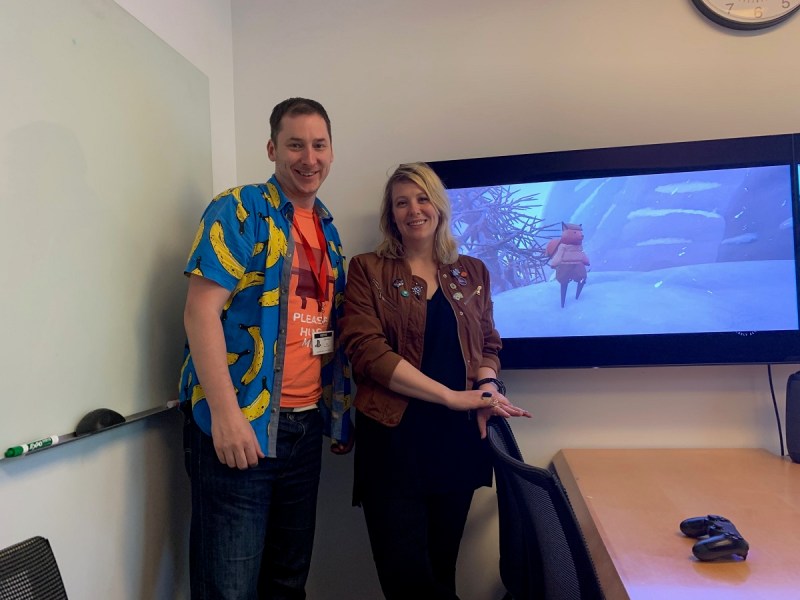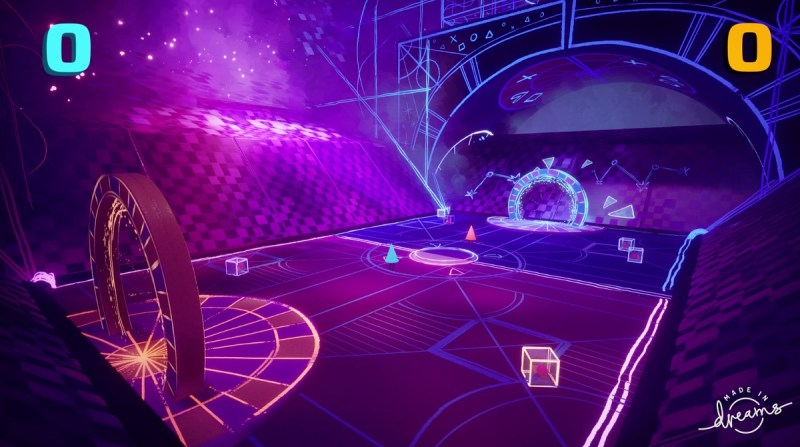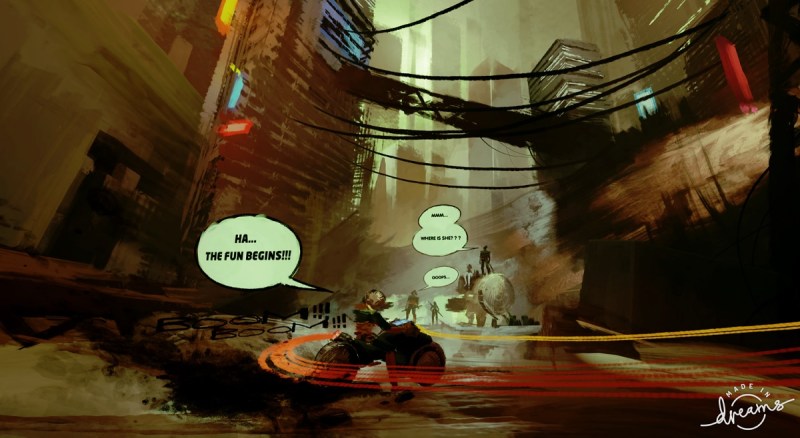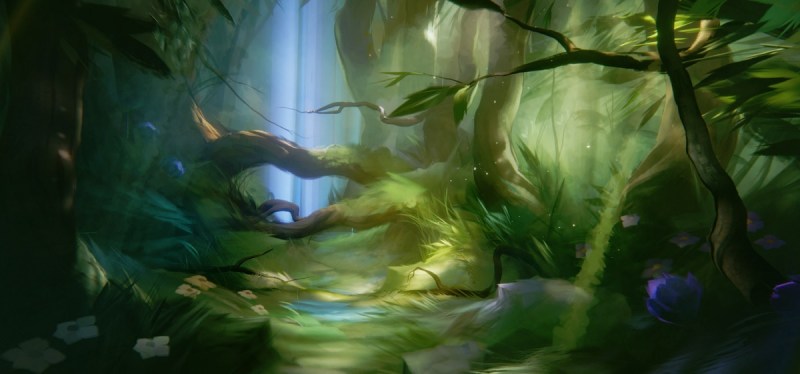Media Molecule has been working on the PlayStation 4 game Dreams for an insanely long time. Viewed as a kind of sequel to LittleBigPlanet, it’s a game where players can create their own dreams. They will be able to share their creations with other players, who can take these ideas and build upon them, creating a neverending tree of user-generated content.
It’s a bit like Microsoft’s failed Project Spark, but in this case, players can create their own fundamental building blocks from scratch. Last month, Media Molecule made Dreams available to players via Early Access, allowing them to create their own game worlds and assets. In the meantime, Media Molecule is working on a single-player story to help players walk through the creation process.
I interviewed Abbie Heppe, communications manager at Media Molecule, and John Beech, its principal designer. They walked me through how it’s easy to create characters, landscape, and gameplay with the Dreams editing tools. And as they showed me their own projects, it dawned on me how great a tool this can be for budding artists, game designers, and other creative types.
Here’s an edited transcript of our interview.

Above: John Beech, principal designer, and Abbie Heppe, communications manager, of Media Molecule.
John Beech: This is where you go to make your dreams. Dream-surfing, where you go check out other people dreams. We have these community jams. We change them up to engage the community. The theme right now is spring, for example. User profiles. We’re going to start by looking at some dreams.
Abbie Heppe: We have this idea of autosurf, which is — if you just want to go in and you don’t know what to play or what to look for, it’ll just take you through a series of dreams. It’s the no-effort version to check out what the community has been making. But if you want to search through here, these are all the games people generally think are finished.
Beech: I set it on recent, so we haven’t seen any of these yet. There’s probably been 20 in the last hour. It’s great seeing all the things people have made. People have made their own UI. It’s pretty cool. On Twitter there’s a hashtag, #madeindreams, and people have been relentlessly sharing stuff.
Heppe: This person has built a full inventory system and dialogue trees for their game. You can check your messages. It’s very cool.
GamesBeat: Can you tell how big some of these are by browsing through?
Heppe: If a user has made their level remixable, which means anybody in the community can take it and make their own version, then you can fly around the map without being in the character and get a sense of the scale of the level. But you can also chain levels together. You can make incredibly big games that go on for — you can make open world games and things like that.
Beech: The breadth of games you can make is insane. You can go from something like that to–this is something someone made in the beta. Bear in mind, it’s only been out a couple of weeks. People have had only so long to get familiar with the tools. That they’ve had the time to produce these kinds of works is just outstanding.

Above: Players can create their own levels in Dreams.
Heppe: If somebody else wanted to make a different hovercraft game, they could take the hovercraft, put it in their level, and build a whole new world for it.
Beech: To go from something like that to where we were before, and then–what’s the side-scrolling one called? Wildfire. You can see remixes of it. “All-Star Edition.” They’ve made all this classic chiptune music to go with it. There are no tools in Dreams that are specifically formaking a 2D platformer or a 3D racing game. We just have a set of generic tools.
Heppe: We’ve seen horror games. We’ve seen platformers. We’ve seen first-person shooters. Lots of people don’t even make games. They make assets for games. They make music. We have one user that’s just made a museum to show off all the art he’s made. People will make
short films, animated films. It’s been fascinating to see all the different genres and tools.
Beech: A student recently used it to finish course work and submit their final piece with a clip from the game. This person has been making a load of assets, and made a museum for all of their sculptures.
Heppe: They just made a whole space for all of their statues and creations. If you look behind John, there’s one in the doorway over here. This is populated with tons of them, and then these monoliths are placeholders for new ones he’s creating. He’s made a whole narrative experience through it. It’s a really creative application of the tools. We could spend a while in there. People have made some pretty lengthy experiences.
GamesBeat: Can you tell which ones are done by game developers?
Heppe: [Laughs] At this point they’re all game developers.
Beech: There’s one I’ll show you in a second where we know he’s a music teacher in New York. He’s been making the most graphically impressive things in Dreams so far. This person here, he’s been very prolific, making music players and gorgeous pieces of scenery.
Heppe: He likes to push the graphical side of the engine. He likes to make things that are lovely graphics. He has such a look.
Beech: He does lots of scenes. But he’s made a few games and levels as well.
GamesBeat: Do you know how many dreams are up altogether?
Beech: The last time we checked it was 40,000, 45,000, something like that. We were doing an interview earlier and they were coming up once every five seconds.
Heppe: As far as full games that are playable, that number is quite a bit smaller, because everything in here you can save and publish. When we give that number we’re counting individual assets. This robot would be one of those things. We have people who just make characters or just make music. We have people who just make grass and trees, or household objects. This person made a music visualizer to go with the music he’s made.
Beech: You can do anything from games to experiences. It’s neverending, essentially. The autosurf feature runs you through them one after another. It’s completely random as well, what you get. But you can search for, say, science fiction, and then it’ll run you through a load of sci-fi. Someone here has made a first-person shooter. You play it for a bit and you may like it, and you can stay here for quite a while, or if you get bored at any point you can give it a thumbs up or thumbs down and skip to the next level. It immediately loads the next level. The loading time is nothing.

Above: Dreams features all kinds of cool art.
GamesBeat: Do you have a way of surfacing the most popular ones?
Heppe: We have the recommendation system. You can also sort by the most popular levels, the most played, or the most recently published, or by creator. That’s one of the things we’re working on improving as we go forward as well, to make sure we’re keeping it current with what the community is doing, so new creators are able to find their way into the top content.
Beech: Once you finish your dream surf–you may stay here for a couple of hours just diving through stuff. When you finish it gives you a list of all the things you played so you can go back and look at them individually, see if they’re remixable, perhaps put them in your own collection. Let’s do some creation.
Heppe: Everything you saw is all created in Dreams with the tools that everyone can access. John’s going to throw together a very quick thing made from scratch. The cool thing about Dreams, and one of the things we’re adding throughout early access, is that Dreams comes with a full slate of tutorials to teach you all the different areas of create. We have templates for different kinds of games. Maybe you’re interested in learning how to make a marble game like we just showed. We have something that allows you to do that.
We also have master classes, if you’ve gotten really in-depth and you want to hear someone like our art director share his tips and tricks. We have asset collections that all work together so people can use them. We give people a lot of jumping-off points to create if they don’t come with an idea already. John’s using the sculpt tool to make some grass. It’s like sculpting with digital clay. You can change your textures. He can easily stamp and clone things around the level to build out the world very quickly.
Beech: The cool thing is, if you don’t feel comfortable creating things from scratch, you can search really simply. In this case I want to find some rocks. You head up here and type in the keywords. I’ve found a rock. You stick that in your level and there it is. You can scale it and shape it to the size you want, and now you have a rock.
Heppe: Not everyone in our community is an asset maker or a content creator. We have people who are just creators. They take the best things and make them into collections for other people to use. We have people who’ve made collections like the one right here, nature assets, or ancient times assets. It’d be everything you need to make your fantasy game. People are really good at curating and showcasing the coolest stuff.
GamesBeat: Are you doing anything like Project Spark did, with a chain of ownership?
Beech: Yes, I should show you that. If there’s any item you find — let’s go look at your level, Princess Cowboy. You can search by dreamer and find your friends. You can follow individual creations. There’s a whole social network here as well. You can leave comments and reviews.
Heppe: This is my profile. When John goes there, he can see my creations. I’ve made this cool architecture space that you can walk around in. You can see how many people have played it and who’s remixed it. I left that comment to someone who made an asset for my level, because it was very cool. If you go to versions and release, you can see the different times I’ve uploaded it and what I’ve changed. You can go back to any one of those.
Then, under genealogy, you can see all these different things. I have all these plants in it that I took from other people in the dream-verse. You can go and visit those individual assets. You can see who’s used my stuff, who’s remixed it. If you go to full credits here, it tells you everyone who participated and everyone whose stuff I’ve used. This is like my game team. It’s very collaborative. We don’t expect everybody to just sit down and make a game. We want people to collaborate and help each other out. We’ve already seen it in the community. We have great music people, and then someone else will come in and help them with something. John’s had people make music tracks for his levels.
Beech: It’s so good. I’m not that musically inclined. I want to make all these special effects and gameplay mechanics. Then I got someone else in the community to make a set of songs for me, because I wanted some smooth jazz. They obliged in a really nice way. It was super.

Above: Dreams has been in the works for more than five years.
GamesBeat: The assets you have, are there Media Molecule images and videos separated from the user-created assets?
Heppe: For each of the different areas in Dreams we have a curated collection of Media Molecule assets. We have more coming throughout early access. Everything will work well. A lot of them have gameplay built in, so that we can help people build those things quickly without having to make art or logic or anything themselves. We also have a full slate of sound effects and instruments. We have lots of ways for people to create without having to just do it all. And the community continues to make stuff like this. This is a community collection, not ours.
Beech: This is just made by — you can see the names. That’s “Lichmaster7.” You can see that I’ve got no inclination toward making a new sculpture. I can just throw a load of things together. It’s a fun way of making things. I find this really therapeutic. Let’s change the sky around a little bit.
Heppe: We have all these gadgets in the game. This is our section that’s all things for helping create gameplay and ambience. The cool thing is, everything you do in the game happens on screen. You’re never waiting for something to render. If you’re just learning the tools it’s easy to play around with these and see what it’s doing. In order to change the time of day, John just picks up the sun and puts it where he wants it to be. That’s helped me too, because is the first 3D creation tool I’ve ever used. Coming in with no experience, all of that visual feedback has helped me figure out how to do a lot of this stuff much quicker.
